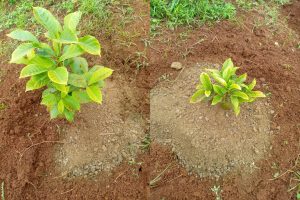Not sure Why Are My or Your Coffee Plant Leaves Turning Yellow? Coffee plant leaves turn yellow due to factors such as nutrient deficiencies, overwatering, pests, or improper light conditions, with potential solutions including adjusting care routines accordingly.

If you’re a coffee lover and have decided to grow your coffee plants at home, you might encounter a common issue that can be quite perplexing – yellowing coffee plant leaves. Don’t fret;
This article will investigate the reasons behind this phenomenon and provide actionable solutions to ensure your coffee plants stay healthy and vibrant.
Why Are My Coffee Plant Leaves Turning Yellow? Here Is Why!
Understanding the Coffee Plant
Before diving into the reasons for yellowing leaves, let’s get to know the coffee plant better.
Coffee plants (Coffea arabica and Coffea canephora, commonly known as Arabica and Robusta, respectively) are known for their lush green leaves and coffee beans they produce.
These plants are native to tropical regions and thrive in warm, humid climates.
The Significance of Healthy Leaves
Healthy leaves play a vital role in the growth and productivity of coffee plants.
They are responsible for photosynthesis, the process through which plants convert light into energy, allowing them to grow and produce coffee cherries.
When the leaves start turning yellow, it’s a sign that something might be amiss with your coffee plant’s overall health.
Common Reasons for Yellowing Coffee Plant Leaves
1. Overwatering
One of the most common mistakes made by novice coffee plant growers is overwatering. Coffee plants prefer their soil to be consistently moist but not waterlogged. When you water your coffee plant excessively, it can lead to root rot, which in turn causes the leaves to turn yellow.
2. Poor Drainage
Related to overwatering, poor drainage can also be a culprit. If your coffee plant’s pot or planting area doesn’t have adequate drainage, excess water can accumulate, suffocating the roots and causing yellowing leaves.
3. Nutrient Deficiency
Coffee plants require specific nutrients to thrive, including nitrogen, phosphorus, and potassium. A lack of these nutrients can lead to nutrient deficiency, manifesting as yellowing leaves. Ensure your plant gets a balanced fertilizer to provide all necessary nutrients.
4. Pest Infestations
Pests such as aphids, mealybugs, and spider mites can wreak havoc on your coffee plant’s leaves. These tiny invaders can suck the sap from the leaves, causing discoloration and eventual yellowing. Regularly inspect your plants for signs of pest infestations.
5. Inadequate Light
Coffee plants are accustomed to bright, indirect sunlight. If your plant doesn’t receive enough light, it may struggle to photosynthesize effectively, leading to yellowing leaves. Consider moving it to a spot with better lighting conditions.
6. Temperature Extremes
Coffee plants are sensitive to temperature fluctuations. Extreme cold or heat exposure can stress the plant, resulting in yellow leaves. Ensure your coffee plant is kept in a stable temperature range.
7. Root Bound
As coffee plants grow, they may become root-bound, meaning their roots outgrow the pot or planting area. This restricts their ability to absorb nutrients, causing leaf discoloration. Repotting your coffee plant into a larger container can alleviate this issue.
Nursing Your Coffee Plant Back to Health
Now that we’ve identified some common reasons for yellowing coffee plant leaves, let’s discuss how to nurse your beloved plant back to health:
- Adjust Your Watering: Ensure the soil is consistently moist but not soggy. Water your plant when the top inch of soil feels dry.
- Improve Drainage: If your coffee plant is in a container, ensure it has drainage holes. If planted in the ground, consider amending the soil for better drainage.
- Fertilize Regularly: Use a balanced, slow-release fertilizer to provide essential nutrients to your coffee plant.
- Pest Control: Regularly inspect your plant for pests and treat them promptly using organic insecticides if necessary.
- Optimal Lighting: Place your coffee plant in a location with bright, indirect sunlight. Consider using artificial grow lights if natural light is insufficient.
- Temperature Maintenance: Protect your plant from extreme temperatures, especially during winter.
- Repot When Needed: If your coffee plant has outgrown its container, repot it into a larger one with fresh potting mix.
Why Are My Coffee Plant Leaves Turning Yellow? FAQs
1. Can I use any fertilizer for my coffee plant?
It’s best to use a balanced, slow-release fertilizer formulated for coffee plants to ensure they receive the right nutrients.
2. How often should I water my coffee plant?
Water your coffee plant when the top inch of soil feels dry. The frequency may vary depending on environmental conditions.
3. What should I do if I suspect a pest infestation?
Inspect your plant for pests regularly. If you find any, treat your plant with an organic insecticide to eliminate them.
4. Can I grow coffee plants indoors?
You can grow coffee plants indoors, provided they receive adequate light and temperature conditions.
5. How long does it take for a coffee plant to produce coffee beans?
It can take several years for a coffee plant to mature and produce coffee beans, typically three to five years or longer.
Conclusion
Yellowing coffee plant leaves can be disheartening, but with the right care and attention, you can restore your plant to its vibrant green glory.
Remember to monitor its watering, ensure proper drainage, provide the necessary nutrients, and protect it from pests and extreme conditions. Your dedication will be rewarded with healthy coffee plants and homegrown coffee beans.
Recent Posts
Who Qualifies For An Extra $144 Added To Their Social Security?
Social Security benefits are a financial lifeline for millions of Americans, providing monthly income to retirees, people with disabilities, and surviving family members. Even a small increase in...
Understanding how much the CEO of Catholic Charities makes is an important question for donors, researchers, and anyone interested in nonprofit transparency. Executive compensation often reflects...